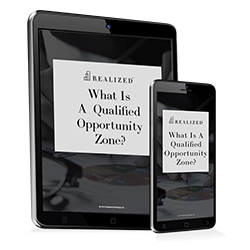
The Employee Retirement Income Security Act of 1974 (ERISA) introduced the individual retirement account. And, the IRA became popular with help from the Economic Recovery Tax Act of 1981. These days, IRAs are positioned to help individuals save for retirement, with tax-deferral advantages.
Individuals can open, and contribute to, their IRAs at any age, as long as they still earn full income. Taxes are assessed either after withdrawal from an IRA (traditional) or during the contribution phase (Roth). As contributions go into an IRA account, they are used to acquire assets, which frequently consist of stocks, bonds, and mutual funds. In other words, traditional investments.
But if you are asking yourself: “Can I move my IRA into an Opportunity Fund?” the answer is: Not unless that Individual Retirement Account is a Self-Directed IRA.
Traditional, Regular, Self-Directed, Solo . . .
There are a great many IRAs out there. One truism, however, is that all IRAs are held, and looked after, by custodians. Custodians, also called trustees, can consist of banks, investment companies, or any other entity approved by the IRS for the purpose of ensuring that the retirement account meets all required government laws and regulations. The custodian is not supposed to provide advice or recommendations as to specific investments, but they usually limit the holdings in the accounts to firm-approved stocks, bonds, mutual funds, or certificates of deposit. They also have mechanisms on hand to acquire those financial instruments, and to secure them.
Unless that custodian is in charge of a Self-Directed IRA, or SDIRA.
Sometimes known as “solo” IRAs, SDIRAs and their custodians are a little more lenient when it comes to account investments, turning over some of the investment decisions to you, the contributor. Through the self-directed IRA, you might have the option to put your contribution dollars into alternative assets, such as real estate, private-placement securities -- and Qualified Opportunity Funds (QOFs).
“How do I know if I have a SDIRA?” you might be asking. Carole Ellis, editor-in-chief of Self-Directed Investor Magazine, offers a foolproof method to help you answer this question. It’s called the “Livestock Test,” and it consists of the following steps.
- Call your IRA custodian
- Ask the custodian if you can invest in cows
- If the answer is “yes,” you have a self-directed IRA
- If the answer is “no,” you don’t
The Conversion Factor
If your IRA is not self-directed, you can convert it into one. To do so, be sure to research, and interview, the SDIRA custodian, to make sure it agrees with your investment objectives. It’s true that the self-directed custodian might be more flexible when it comes to approving alternative investments. However, the IRA’s charter could be more restrictive .
Even if the IRA’s custodian you target is a fervent supporter of the Qualified Opportunity Zone program, other issues you need to know before signing on the dotted line include:
- The steps necessary to convert your current IRA into a SIDRA
- How long it will take the SIDRA custodian to approve, and handle, transaction-related requests
- Fees involved with any SIDRA-related transactions
If you don’t want to deal with administrative red tape, but still want to put funds into an IRA for safekeeping, you could become your own custodian through a structure known as the IRA LLC. This setup is colloquially known as the “Checkbook IRA,” and allows you complete control over the account, its distributions, and its holdings.
While the IRA LLC allows you free reign in how you choose to invest those tax-deferred contributions, there is a reason why not every investor wants to open one. The IRA LLC requires a great deal of paperwork and adherence to specific regulations. It also necessitates a specific bank account, separate tax ID number, and regular government filings. Not many are able, or willing, to keep up with the conditions of the Checkbook IRA.
Finally, whether you decide on a SIDRA or IRA LLC, it’s important to keep in mind that your current IRA’s custodian might not be all that eager to lose you as a client. Certainly, that entity can’t prevent you from moving on, but it doesn’t have to be quick about granting permission for you to do so, either. You might have to wait anywhere from 30 to 90 days for the release of funds from your old IRA account, and conversion into the new one.
If all else fails, you could shut down your traditional-investment IRA, then reinvest the proceeds into a self-directed structure. The downside with this method is a rather large tax bite.
Invest with Care
The answer to the question: “Can I move my IRA into an Opportunity Fund” is “it depends.” It depends on the type of IRA you have, and it depends on the custodian in charge of your account.
IRA custodians are responsible for following IRS and government regulations, as well as keeping an eye on investments allowed under the charters. SDIRA custodians can provide more flexibility, with Checkbook IRAs providing the most flexibility of all. The one piece of advice offered here is, before you determine the best type of IRA for you, perform your in-depth due diligence, and understand your expectations.
For more information about investing in Qualified Opportunity Funds, contact Realized holdings at www.realized1031.com, or call (877) 797-1031.



